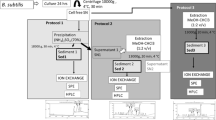Abstract
Large-scale purification of the highly hydrophobic bacteriocin thurincin H was accomplished via a novel and simple two-step method: ammonia sulfate precipitation and C18 solid-phase extraction. The inhibition spectrum and stability of thurincin H as well as its antagonistic activity against Bacillus cereus F4552 spores were further characterized. In the purification method, secreted proteins contained in the supernatant of a 40 h incubated culture of B. thuringiensis SF361 were precipitated by 68 % ammonia sulfate and purified by reverse-phase chromatography, with a yield of 18.53 mg/l of pure thurincin H. Silver-stained SDS–PAGE, high-performance liquid chromatography, and liquid chromatography–mass spectrometry confirmed the high purity of the prepared sample. Thurincin H exhibited a broad antimicrobial activity against 22 tested bacterial strains among six different genera including Bacillus, Carnobacterium, Geobacillus, Enterococcus, Listeria, and Staphylococcus. There was no detectable activity against any of the selected yeast or fungi. The bacteriocin activity was stable for 30 min at 50 °C and decreased to undetectable levels within 10 min at temperatures above 80 °C. Thurincin H is also stable from pH 2–7 for at least 24 h at room temperature. Thurincin H is germicidal against B. cereus spores in brain heart infusion broth, but not in Tris–NaCl buffer. The efficient purification method enables the large-scale production of pure thurincin H. The broad inhibitory spectrum of this bacteriocin may be of interest as a potential natural biopreservative in the food industry, particularly in post-processed and ready-to-eat food.



Similar content being viewed by others
References
Scallan E, Griffin PM, Angulo FJ, Tauxe RV, Hoekstra RM (2011) Foodborne illness acquired in the United States—major pathogens. Emerg Infect Dis 17(1):7–15
Nicholson WL, Munakata N, Horneck G, Melosh HJ, Setlow P (2000) Resistance of Bacillus endospores to extreme terrestrial and extraterrestrial environments. Microbiol Mol Biol Rev 64(3):548–572
Cotter PD, Hill C, Ross RP (2005) Bacteriocins: developing innate immunity for food. Nat Rev Microbiol 3(10):777–788
Settanni L, Corsetti A (2008) Application of bacteriocins in vegetable food biopreservation. Int J Food Microbiol 121(2):123–138
Abriouel H, Franz CM, Ben Omar N, Galvez A (2011) Diversity and applications of Bacillus bacteriocins. FEMS Microbiol Rev 35(1):201–232
Stein T (2005) Bacillus subtilis antibiotics: structures, syntheses and specific functions. Mol Microbiol 56(4):845–857
Oman TJ, van der Donk WA (2009) Insights into the mode of action of the two-peptide lantibiotic haloduracin. ACS Chem Biol 4(10):865–874
Lee H, Churey JJ, Worobo RW (2009) Biosynthesis and transcriptional analysis of thurincin H, a tandem repeated bacteriocin genetic locus, produced by Bacillus thuringiensis SF361. FEMS Microbiol Lett 299(2):205–213
Pol IE, van Arendonk WG, Mastwijk HC, Krommer J, Smid EJ, Moezelaar R (2001) Sensitivities of germinating spores and carvacrol-adapted vegetative cells and spores of Bacillus cereus to nisin and pulsed-electric-field treatment. Appl Environ Microbiol 67(4):1693–1699
Daba H, Pandian S, Gosselin JF, Simard RE, Huang J, Lacroix C (1991) Detection and activity of a bacteriocin produced by Leuconostoc mesenteroides. Appl Environ Microbiol 57(12):3450–3455
Manns DC, Churey JJ, Worobo RW (2012) Functional assignment of YvgO, a novel set of purified and chemically characterized proteinaceous antifungal variants produced by Bacillus thuringiensis SF361. Appl Environ Microbiol 78(8):2543–2552
Schägger H (2006) Tricine-SDS-PAGE. Nat Protoc 1(1):16–22
Eijsink VG, Skeie M, Middelhoven PH, Brurberg MB, Nes IF (1998) Comparative studies of class IIa bacteriocins of lactic acid bacteria. Appl Environ Microbiol 64(9):3275–3281
Fujita K, Ichimasa S, Zendo T, Koga S, Yoneyama F, Nakayama J, Sonomoto K (2007) Structural analysis and characterization of lacticin Q, a novel bacteriocin belonging to a new family of unmodified bacteriocins of gram-positive bacteria. Appl Environ Microbiol 73(9):2871–2877
Hornstra LM, de Vries YP, de Vos WM, Abee T, Wells-Bennik MH (2005) gerR, a novel ger operon involved in L-alanine- and inosine-initiated germination of Bacillus cereus ATCC 14579. Appl Environ Microbiol 71(2):774–781
Moir A, Smith DA (1990) The genetics of bacterial spore germination. Annu Rev Microbiol 44:531–553
Chen H, Hoover DG (2003) Bacteriocins and their food applications. Compr Rev Food Sci Food Saf 2(3):82–100
Riley MA, Gordon DM (1999) The ecological role of bacteriocins in bacterial competition. Trends Microbiol 7(3):129–133
Singh J, Banerjee N (2008) Transcriptional analysis and functional characterization of a gene pair encoding iron-regulated xenocin and immunity proteins of Xenorhabdus nematophila. J Bacteriol 190(11):3877–3885
Sit CS, van Belkum MJ, McKay RT, Worobo RW, Vederas JC (2011) The 3D solution structure of thurincin H, a bacteriocin with four sulfur to alpha-carbon crosslinks. Angew Chem Int Ed Engl 50(37):8718–8721
Suma K, Misra MC, Varadaraj MC (1998) Plantaricin LP84, a broad spectrum heat-stable bacteriocin of Lactobacillus plantarum NCIM 2084 produced in a simple glucose broth medium. Int J Food Microbiol 40(1–2):17–25
Drider D, Fimland G, Hechard Y, McMullen LM, Prevost H (2006) The continuing story of class IIa bacteriocins. Microbiol Mol Biol Rev 70(2):564–582
Wu S, Jia S, Sun D, Chen M, Chen X, Zhong J, Huan L (2005) Purification and characterization of two novel antimicrobial peptides subpeptin JM4-A and subpeptin JM4-B produced by Bacillus subtilis JM4. Curr Microbiol 51(5):292–296
Stewart GS, Johnstone K, Hagelberg E, Ellar DJ (1981) Commitment of bacterial spores to germinate. A measure of the trigger reaction. Biochem J 198(1):101–106
Acknowledgments
This research was supported by USDA-CSREES (Project # 2008-51110-0688).
Conflict of interest
The authors declare no conflict of interest.
Author information
Authors and Affiliations
Corresponding author
Rights and permissions
About this article
Cite this article
Wang, G., Manns, D.C., Guron, G.K. et al. Large-Scale Purification, Characterization, and Spore Outgrowth Inhibitory Effect of Thurincin H, a Bacteriocin Produced by Bacillus thuringiensis SF361. Probiotics & Antimicro. Prot. 6, 105–113 (2014). https://doi.org/10.1007/s12602-014-9159-1
Published:
Issue Date:
DOI: https://doi.org/10.1007/s12602-014-9159-1




